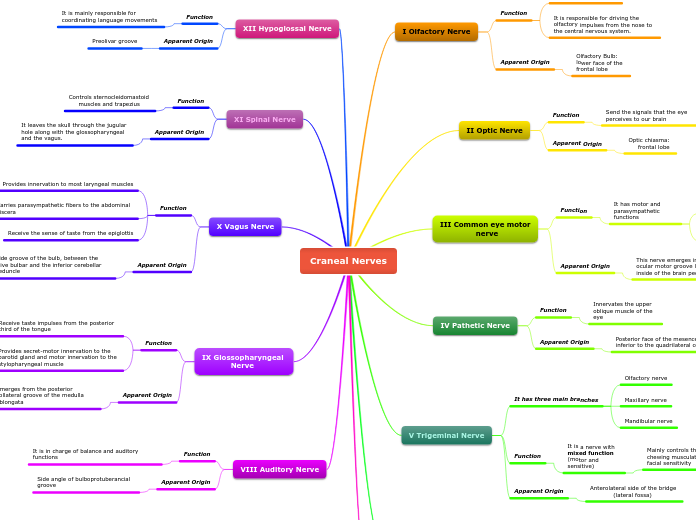Craneal Nerves
I Olfactory Nerve
Function
Its function is sensitive
It is responsible for driving the olfactory impulses from the nose to the central nervous system.
Apparent Origin
Olfactory Bulb:
lower face of the frontal lobe
II Optic Nerve
Function
Send the signals that the eye perceives to our brain
Apparent Origin
Optic chiasma:
frontal lobe
III Common eye motor
nerve
Function
It has motor and parasympathetic functions
Motor:It is one of the nerves that controls eye movement
Parasympathetic: Responsible for pupil size
Apparent Origin
This nerve emerges in the common ocular motor groove located on the inside of the brain peduncles.
IV Pathetic Nerve
Function
Innervates the upper oblique muscle of the eye
Apparent Origin
Posterior face of the mesencephalic
inferior to the quadrilateral colicules
V Trigeminal Nerve
It has three main branches
Olfactory nerve
Maxillary nerve
Mandibular nerve
Function
It is a nerve with mixed function (motor and sensitive)
Mainly controls the chewing musculature and facial sensitivity
Apparent Origin
Anterolateral side of the bridge
(lateral fossa)
VI Abducens Nerve
Function
It innervates the lateral rectus muscle of the eyeball, being responsible for turning the eye outward
Apparent Origin
Bulboprotuberancial groove at the level of the pyramids
XII Hypoglossal Nerve
Function
It is mainly responsible for coordinating language movements
Apparent Origin
Preolivar groove
XI Spinal Nerve
Function
Controls sternocleidomastoid
muscles and trapezius
Apparent Origin
It leaves the skull through the jugular
hole along with the glossopharyngeal
and the vagus.
X Vagus Nerve
Function
Provides innervation to most laryngeal muscles
Carries parasympathetic fibers to the abdominal viscera
Receive the sense of taste from the epiglottis
Apparent Origin
Side groove of the bulb, between the olive bulbar and the inferior cerebellar peduncle
IX Glossopharyngeal
Nerve
Function
Receive taste impulses from the posterior third of the tongue
Provides secret-motor innervation to the parotid gland and motor innervation to the stylopharyngeal muscle
Apparent Origin
Emerges from the posterior collateral groove of the medulla oblongata
VIII Auditory Nerve
Function
It is in charge of balance and auditory functions
Apparent Origin
Side angle of bulboprotuberancial groove
VII Facial Nerve
Function
It is a mixed nerve, with mainly motor function and with a sensitive portion
Collect taste impressions of the previous two thirds of the language
Apparent Origin
Bulboprotuberancial groove at olive level
